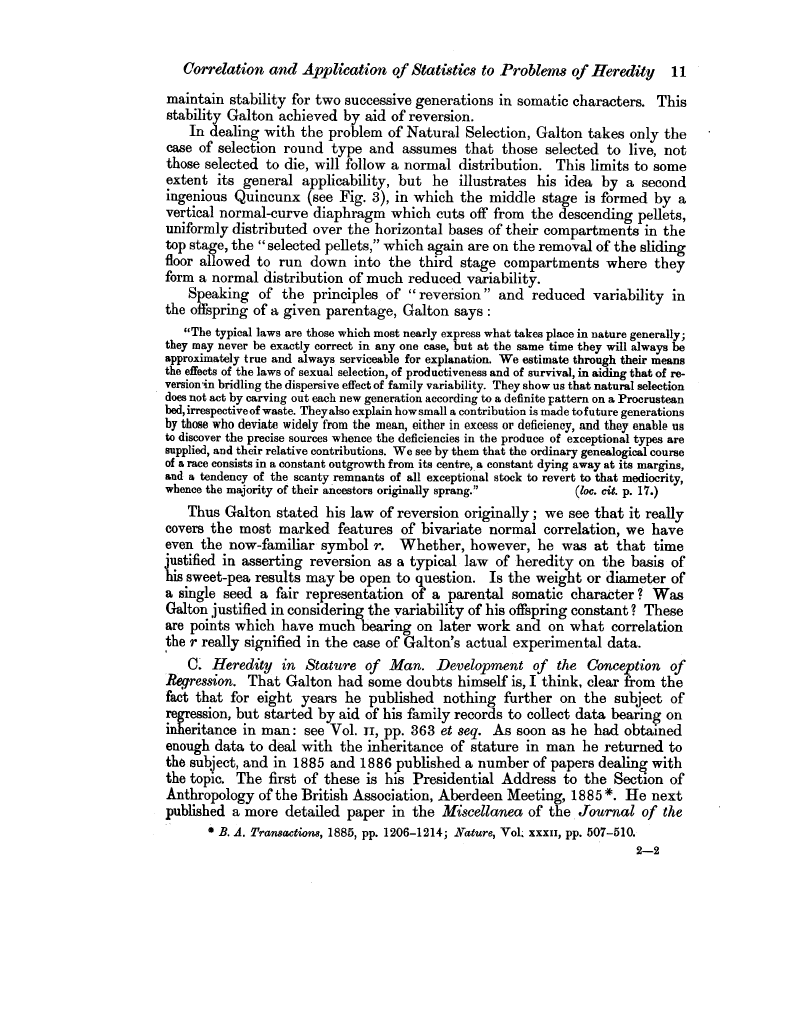| ||||||

OCR Rendition - approximate
Correlation and Application of Statistics to Problems of Heredity 11 maintain stability for two successive generations in somatic characters. This stability Galton achieved by aid of reversion. In dealing with the problem of Natural Selection, Galton takes only the case of selection round type and assumes that those selected to live, not those selected to die, will follow a normal distribution. This limits to some extent its general applicability, but he illustrates his idea by a second ingenious Quincunx (see Fig. 3), in which the middle stage is formed by a vertical normal-curve diaphragm which cuts off from the descending pellets, uniformly distributed over the horizontal bases of their compartments in the top stage, the "selected pellets," which again are on the removal of the sliding floor allowed to run down into the third stage compartments where they form a normal distribution of much reduced variability. Speaking of the principles of " reversion " and reduced variability in the offspring of a given parentage, Galton says "The typical laws are those which most nearly express what takes place in nature generally; they may never be exactly correct in any one case, but at the same time they will always be approximately true and always serviceable for explanation. We estimate through their means the effects of the laws of sexual selection, of productiveness and of survival, in aiding that of reversionin bridling the dispersive effect of family variability. They show us that natural selection does not act by carving out each new generation according to a definite pattern on a Procrustean bed, irrespective of waste. They also explain how small a contribution is made to future generations by those who deviate widely from the mean, either in excess or deficiency, and they enable us to discover the precise sources whence the deficiencies in the produce of exceptional types are supplied, and their relative contributions. We see by them that the ordinary genealogical course of a race consists in a constant outgrowth from its centre,, a constant dying away at its margins, and a tendency of the scanty remnants of all exceptional stock to revert to that mediocrity, whence the majority of their ancestors originally sprang." (loc. cit. P. 17.) Thus Galton stated his law of reversion originally ; we see that it really covers the most marked features of bivariate normal correlation, we have even the now-familiar symbol r. Whether, however, he was at that time justified in asserting reversion as a typical law of heredity on the basis off his sweet-pea results may be open to question. Is the weight or diameter of a single seed a fair representation of a parental somatic character? Was Galton justified in considering the variability of his offspring constant? These are points which have much bearing on later work and on what correlation the r really signified in the case of Galton's actual experimental data. C. Heredity in Stature of Man. Development of the Conception of Regression. That Galton had some doubts himself is, I think, clear from the fact that for eight years he published nothing further on the subject of regression, but started by aid of his family records to collect data bearing on inheritance in man : see Vol. II, pp. 363 et seq. As soon as he had obtained enough data to deal with the inheritance of stature in man he returned to the subject, and in 1885 and 1886 published a number of papers dealing with the topic. The first of these is his Presidential Address to the Section of Anthropology of the British Association, Aberdeen Meeting, 1885 *. He next published a more detailed paper in the Miscellanea of the, Journal of the * B. A. Transactions, 1885, pp. 1206-1214; Nature, Vol. xxxii, pp. 507-510. 2-2
|